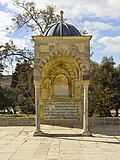The Dome of Yusuf – honoring Saladin, a 12th-century sultan – is on the Temple Mount in the Old City of Jerusalem.
The Dome of Yusuf (Arabic: قبة يوسف Qubbat Yūsuf) is a free-standing domed structure on the Temple Mount, located south of the Dome of the Rock.
It was built by Saladin (born Yusuf) in the 12th century, and has been renovated several times.[1][2][3] It bears inscriptions from the 12th and 17th centuries: one dated 1191 in Saladin's name, and two mentioning Yusuf Agha, possibly a governor of Jerusalem or a eunuch in the Ottoman imperial palace.[1][4][5]
- ^ a b Carole Hillenbrand (2000). The Crusades: Islamic perspectives (Illustrated, reprint, annotated ed.). Routledge. p. 191. ISBN 978-0-415-92914-1.
a monumental inscription dated 587(AH)/1191 in [Saladin's] name on the Dome of Joseph [Qubbat Yusuf] on the Haram esplanade: 'the victorious king, the probity of this world and of [true] religion, the Sultan of Islam and of the Muslims, the servant of the two noble sanctuaries and of Jerusalem.'
- ^ Necipoğlu, Gülru (1998). Muqarnas: An Annual on the Visual Culture of the Islamic World (Illustrated, annotated ed.). BRILL. p. 73. ISBN 978-90-04-11084-7.
- ^ Myriam Rosen-Ayalon (2006). Islamic art and archaeology in Palestine (Illustrated ed.). Left Coast Press. p. 97. ISBN 978-1-59874-064-6.
- ^ [dead link] Qubbat Yusuf Archived August 5, 2011, at the Wayback Machine Archnet Digital Library.
- ^ [dead link] Al-Aqsa Guide Friends of al-Aqsa 2007. Archived December 20, 2008, at the Wayback Machine

